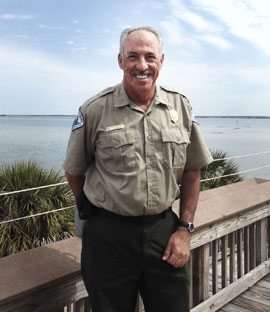
“I applied on a lark,” he says. “I always loved the outdoors – fishing, boating, hiking, and camping – so thought it would be a great place to work.”
Now park manager for Honeymoon Island, Krulder spends more time than he would like behind a desk, calmly coordinating staff and volunteers while navigating a course between vocal user groups.
“A lot of what we do is education – people hear something and it gets exaggerated and emotions ride high.”
Case in point is the recently updated unit management plan for Anclote Key Preserve, with a somewhat controversial proposal to close part of the beach to boaters. “It’s considered an area of global significance because it provides critical habitat for endangered birds including plovers, American oystercatchers and terns. Boaters heard we were going to close the entire beach but the plan was always to close part of the beach for part of the year.”
As the plan heads to Tallahassee for final approval, it calls for closing 1,800 feet of beach on Three Rooker Island for 90 days to allow beach-nesting birds the space they need to nest successfully. “That’s 1,800 feet of 10,000 feet of usable beach for three months during the nesting season,” he said. “There’s plenty of beach there – we need to leave a little space for the birds.”
Unit management plans, updated every 10 years, give citizens a chance to voice their opinions about how the state’s parks should be used. “If someone wants to come in and tell us they think we should build resorts and casinos, this is their opportunity. Other people want to close or severely restrict access to the entire preserve to protect habitat and they have the right to voice that opinion. We have to find the balance that doesn’t infringe on critical habitat but does support visitors.”
He stood firm as hundreds of people jammed a community center in Dunedin to protest plans for additional RV camping on Honeymoon Island. “My job is to do the will of the people of Florida. Clearly nobody wanted more RVs here.”
[su_pullquote align=”right”]We had a lot of people getting married on the beach so we planned the South Beach Pavilion to offer a place for after-hours receptions.[/su_pullquote]They did support a plan to build another concession stand that grew into a facility that seats up to 80 people.Along with Honeymoon Island and Anclote Key, Krulder is responsible for managing Egmont Key, Caladesi and the Skyway Fishing Pier, where a new program created in partnership with local Audubon Societies is helping prevent bird deaths caused by fishing line (See Bay Soundings, Winter 2014).
Volunteers are critical to the state parks, he notes. Last year, 27,000 volunteers worked 1.3 million hours doing everything from taking tolls at entry gates and answering phones to working as bird stewards. Partnerships with community organizations also have been key in improving park facilities. Both the Rotary Centennial Nature Center at Honeymoon Island and the restoration of the historic lighthouse at Anclote Key were funded through donations raised by private groups. The latest effort is a $600,000 observation tower at Caladesi in the footprint of the former fire tower with elevator access to serve handicapped people. “These groups are amazing – if I ask for something, I know I’ll get it.”
But even as his job requires more time at a desk, Krulder yearns to spend more time outside. He calls it “playing with squirrels,” and takes advantage of every opportunity to show a visitor around. Tours are highlighted with a trip to the bald eagle nest where photographers gather nearly every day during nesting season and volunteers provide a scope for visitors to get an up-close glimpse of the birds. An indistinguishable pine tree at what was once the northern tip of the island is actually more than 200 years old. And if you’ve ever wondered about the need for beach nourishment, he’ll show you a parking lot that’s falling into the gulf.
He’s already signed up to lead a nature tour on Earth Day – a tradition he makes time for, even when administrative tasks are calling him away from what he’d rather be doing. “The interpretive programs are my favorite part of the job. We need to get people out here so they can see what a special place it is. The more they see, the more they’ll want to protect it.”
[su_divider]